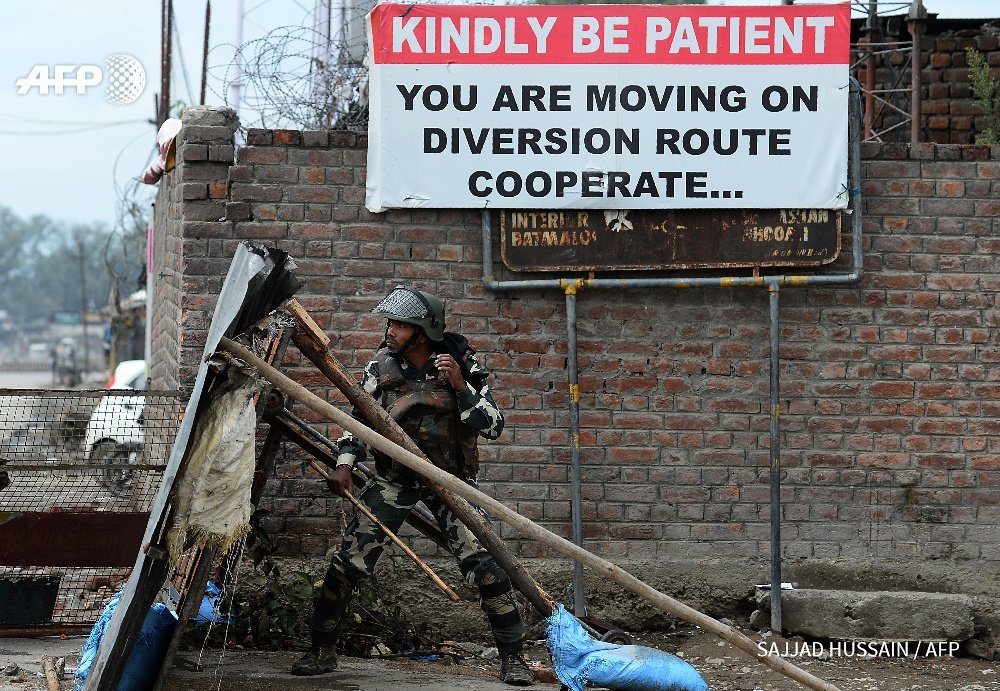
An Indian trooper shelters behind tin sheeting during clashes with Kashmiri protestors in Srinagar #India #pakistan #dispute #killings #demo: image via sajjad hussain @sajjadkmr, 4 September 2016
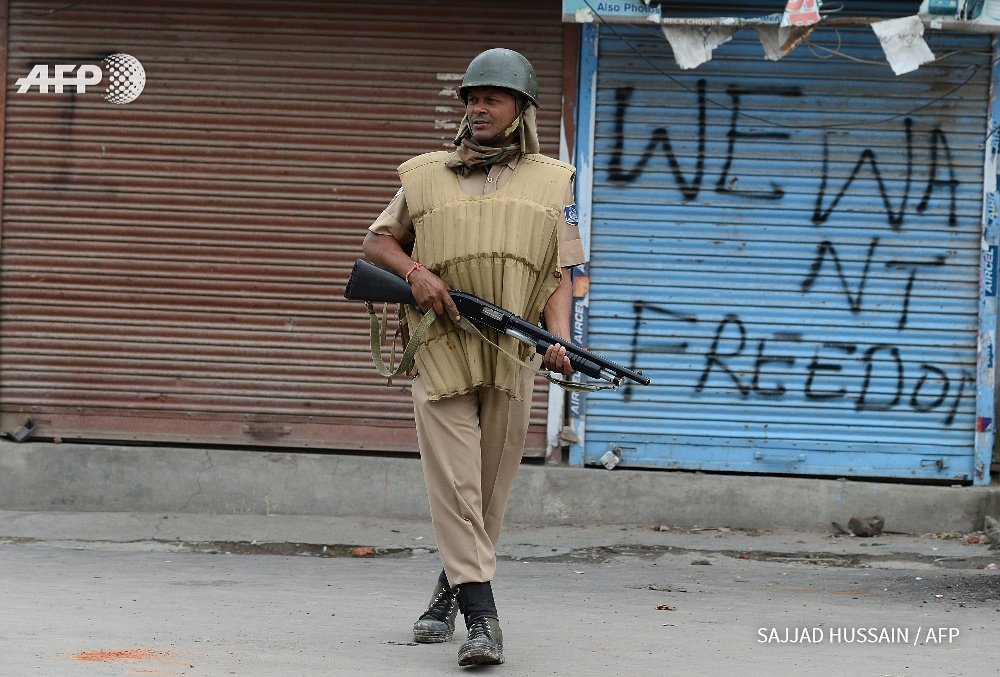
Neolithic Intifada: Though freedom is a distant thing, resistance is in our blood
Rock Revolution. The four stone-pelters Outlook spoke to in Srinagar: photo by Faisal Khan for Outlook, 12 September 2016
Armed With The Original Weapon: Four stone-pelters from Kashmir talk about their lives, their motivations and the neolithic intifada: Showkat A. Motta in Srinagar with Aasif Sultan, Outlook: The Magazine, 12 September 2016
When the Mughals invaded Kashmir in the late 16th century, they
built a fort on a hilltop in Srinagar. It’s part of folk history that,
brimming with anger, young Kashmiri men would clandestinely appear on
the streets of old Srinagar. Holding stones in their hands, these men
would divide themselves into small groups, and on seeing Mughal
soldiers coming down from barracks on the hilltop, hurl the stones at
them, prompting them to retreat. This act of resistance to the Mughal
occupation would earn the young men the title of Dilawar or braveheart.
More than four centuries later, the primitive stone continues to be the weapon of choice for yet another generation of angry Kashmiris. They say they are carrying forward the ‘torch of freedom’. Incidentally, the area of Nowhatta, a stone’s throw from the historic Mughal fort, still remains, after 430 years, the ground zero of stone-pelting protests in the Valley.
Stone-pelting is not, however, confined to the alleys of downtown
Srinagar. It has spread far and wide, to villages and towns across the
Valley and also the Muslim-majority Chenab valley of Jammu. It
intensified after the 2008 agitation over transfer of forest land to the
Amarnath shrine board and later during the 2010 agitation. Since then,
stone-pelting has remained a weekly affair, taking place on Fridays.
This summer, it has become a daily affair.
Even after the curfew which lasted 52 days was lifted, the facade of
normalcy that often cloaks Kashmir is missing from the streets. What
remains is groups of boys holding stones in their hands.
Why do these boys, mostly educated and tech-savvy, nurse such deep
hatred in their hearts? What is their idea of azadi? What drives them to
risk their lives? Do they receive money for throwing stones?
To know answers to these and many more questions, Outlook
met four stone-pelters in the middle of a stringent curfew in restive
downtown, where the walls are painted: ‘Go India, go back’, ‘Indian dogs
go back’, and ‘Pakistan zindabad’. These youths, all of them teenagers,
refused to take off their masks before the camera and revealed only
their first name.
They shared a common thread of experience: all have been witness to,
or have experienced first-hand, beatings, torture, harassment and
humiliation at the hands of the security forces. Throwing stones, the
boys admitted, is a kind of cathartic release for them. “We’re making a
political statement by throwing stones. India is an aggressor; it is
unwelcome here.”
"I no longer fear arrest and death. Even my family understands now. Earlier, they would stop me from protesting. No more.”
A successful career is the last thing on the mind of
these boys. They laugh off the suggestion that they are paid money by
separatists to pelt stones and that Pakistan and its secret agency ISI
are behind them. (The authorities too have failed to establish the money
angle so far.) They also understand that their stones would not result
in the end of Indian rule in Kashmir, at least in the foreseeable
future, and can only invite bullets, pellets or teargas shells, often
blinding them for life or leaving them dead.
Also, contrary to the oft generated suspicion by sections of the
mainstream, it appears that it’s not religion that drives these
teenagers to the streets.
Although they wear masks scribbled with
pro-Pakistan slogans, carry Pakistani flags and in one instance, one of
them even brandished an ISIS flag, none of them mentioned Islam or
‘Islamisation of Kashmir’ even once. Their story in their own words:
Farooq, 17, student: I have three sisters. My father
is aging and my family looks to me as the breadwinner. I know I figure
on the police radar for actively participating in stone-pelting
protests. Sooner or later, I will be arrested, jailed or even killed. I
also understand that it will be my father, or my sisters, who will have
to beg and bribe the local thanedar for my release. Yet, in spite of all
this, I choose to be a stone-thrower.
When I take part in stone pelting, I am conscious of the fact that I
may die. But I no longer fear arrest and death. Even family understands
this now. Earlier, they would stop me from joining protests. No more.
Life seems meaningless and empty when you see death up-close. I feel
anger building up inside me. It’s when you no longer apply your mind
that you go to the extreme.
During the past 50 days, I have hardly spent a night at home. My
parents and my sisters long to see me. But I know that azadi doesn’t
come cheap. You have to keep on offering sacrifice for achieving the
goal. I lost many friends during the 2010 movement. I was just 11 then.
Even this year, Yasir, a teenager, was shot dead in front of me. When
you witness such things, you don’t need any one to motivate you to throw
stones.
Tricks. A Kashmiri youth stands in front of blackened ISIS graffiti in Srinagar.: photo by Faisal Khan for Outlook, 12 September 2016
That we are paid to throw stones is nothing less than a filthy
insinuation. Do you think anyone will risk his life by taking on bullets
and pellets for a few hundred rupees? Do you know how it feels after
being hit by a bullet or a teargas shell? The pain is killing. They say
that the security forces are to here to protect us. That’s a complete
lie. It’s they who are paid to kill us. This movement will stop after
the last Indian soldier leaves Kashmir. I may not see the dawn of azadi,
but it’s now our duty to keep the movement alive. The torch of freedom
has to be carried forward. One day we will be an azad country.
Bashir, 19, salesman: Stone-throwing is not
cricket. It’s as serious as picking a gun and becoming a militant. It’s
another form of resistance against India. I heard that Jews jail
Palestinians for 20 years for throwing stones. I’m sure such a
draconian law will find its way to Kashmir too. Yet, such measures only
harden us, turn us stone-like.
We are not paid by anyone. Indians say stone-throwers are ready to
die for Rs 500 paid by Pakistan. Do you think I will face bullets for
just Rs 500? That is too cheap a price for a life! What is the
aftermath of stone throwing -- FIRs, torture, jail, constant harassment of
family members. Who would volunteer for this nightmare -- and for just Rs
500?
To protect ourselves from teargas, rubbing toothpaste around eyes or putting a pinch of salt under the tongue helps. What other means are left with us when they handle peaceful protests with teargas shells and bullets? It’s only stones through which we make ourselves heard.
I was a child in 2008 (when the Amarnath land agitation broke out)
when I picked the first stone. Since then, my hatred for India has only
surged. But my biggest worry is that our leadership should not sell us
like they did in 2008 and 2010. If this time our leadership succumbs to
pressures and no result-oriented measures (towards resolution of the
Kashmir issue) are taken, I will call it a day. I will not take to the
streets and engage with ruthless cops any more.
You’ll be surprised to know that my brother works in the police. But
for me, he is just like any other CRPF trooper. Both represent India in
Kashmir. He acknowledges that India is an oppressor, but he has chosen
to side with them. Sometimes our discussions lead to confrontations. So,
in a sense, I’m fighting the oppressor both at home and outside.
Wamiq, 15, student: Recently, a bullet pierced my
abdomen, injuring me critically. A cop shot at me from a point-blank
range with the clear intention to kill. But Allah saved me and allowed a
speedy recovery. When my parents came to know about my injury, they
virtually beseeched me to stop pelting stones. But I told them, without
mincing any words, that I want to attain martyrdom.
Some days ago, the police killed my friend Irfan Wani, an 18-year-old
from Fateh Kadal in downtown Srinagar. It was a target killing, as
Irfan was a mentor for hundreds of stone-throwers like me. He had 21
FIRs in different police stations in Srinagar. They were hounding him
round the clock. If he hadn’t had two unmarried sisters and a widowed
mother to take care of, he would have joined militants long ago. I am
yet to find a stone-thrower like him anywhere in Kashmir.
Since guns aren’t available -- though I tried hard to get one -- all I have
is a stone in my hand. I don’t see any difference between a brother
killed with a gun in his hand or a youth killed while throwing stones.
Both are martyrs in the cause of azadi.
Our stones have frustrated the Indians. They have now infiltrated
their agents into our ranks. But that won’t end it. The 2010 agitation
had paid PDP stone throwers. Now in 2016, there are some stone-throwers
belonging to National Conference. I have seen them. If the Indians are
referring to these pre-paid and post-paid stone-throwers, then it is
true. However, they actually want to say that it’s Pakistan and the
Hurriyat which is paying us. It’s a preposterous charge.
I don’t follow any leader. In fact, most political leaders see stone
pelting as a threat to their own agenda. They know they can’t thrust
anything here until this resistance is alive. I, for one, have never met
a Hurriyat leader. But we do follow their protest calendars in letter
and spirit and respect their decisions. I am fighting my battle with
stones and arguments. My two uncles were working with the police and I
convinced one to resign.
Some people try to pacify us by pointing towards the repercussions.
We have seen it all. I had to move during nights for dressing up my
wound. I want to tell my enemy that to stop stone-throwing in Kashmir,
they will have to kill the entire stone-throwing army. After all,
don’t we have more than 50,000 children orphaned in the conflict?
Rayan, 15, student: I am aware that by throwing
stones we’ll not get rid of Indian rule. India is a powerful country and
has led an all-out war against us. It is a symbolic form of resistance.
We want to tell India that you can rule our land but not our hearts and
minds. When you see an eight-year-old child beaten to death, you stop
thinking normally. You start hating the occupier and want to do
everything that will hurt them. Azadi marches and sit-INS may be
sponsored but not stone throwing. Those who utter such nonsense have no
idea of the Kashmiri psyche. I wish guns were as freely available today
as they were in the 1990s. There would be a mass armed movement, better
organised and more effective than the previous one. I would be the first
to enlist.
The Kashmiri leadership has tried to solve the issue peacefully, but
we have been betrayed each time. In fact, it has been a misjudgement by
our leaders to trust New Delhi time and again. But New Delhi must know
that the more they oppress Kashmiris, the more rage it will generate
against them -- and we will continue to resist.

Masked protesters in #Kashmir must be shot at. Soldiers and cops have clear responsibilities. #PakistanJihad: image via Tufail Ahmad Verified account @tufailelif, 3 September 2016
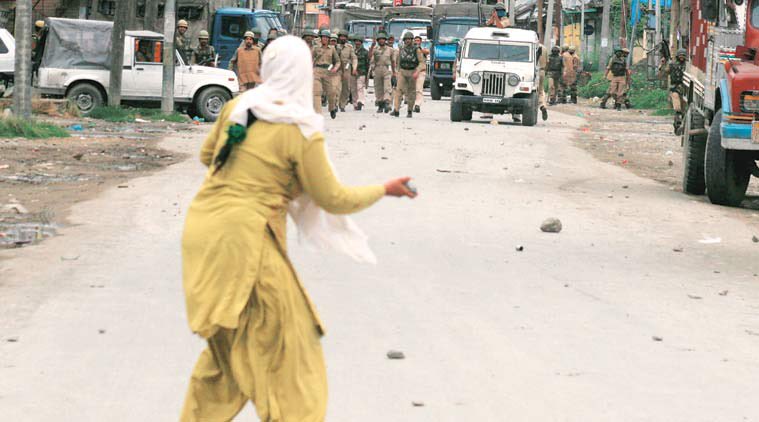
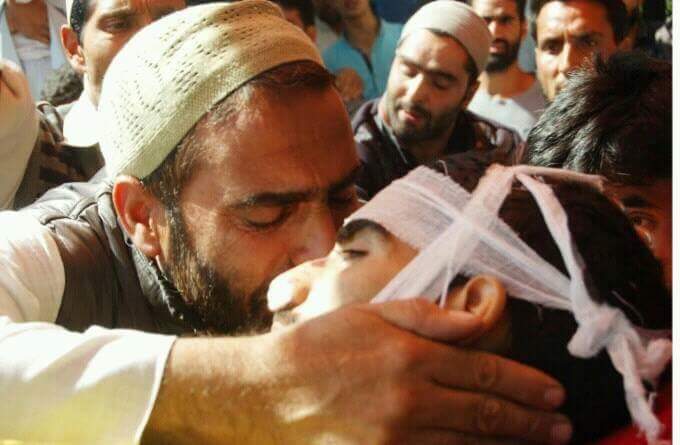
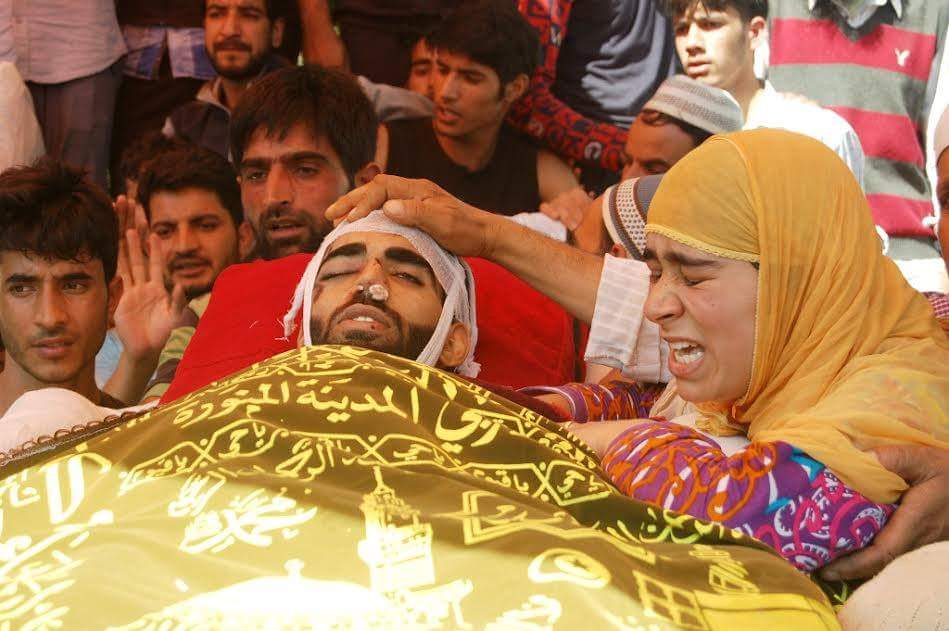
Bidding him adieu. Yet another victim of atrocities in #Kashmir: image via Kashmir Global @kashmirglobal, 4 September 2016

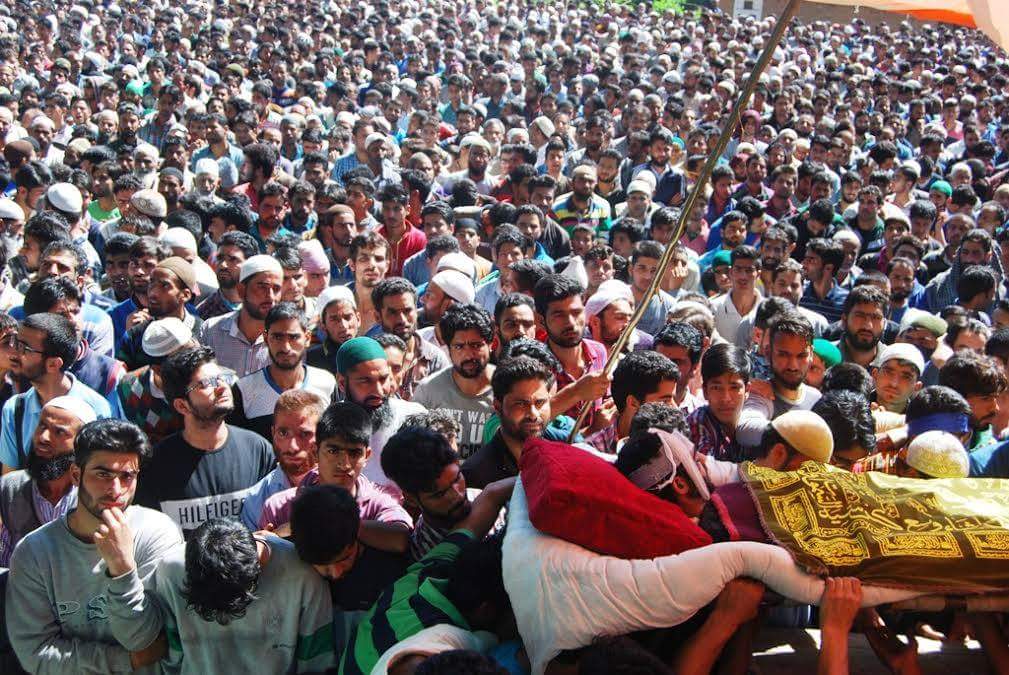
Bidding him adieu. Yet another victim of atrocities in #Kashmir: image via Kashmir Global @kashmirglobal, 4 September 2016

Technically, if there is a paid stone pelter in #Kashmir, this is it: image by Fouad Farooq @fouadfarooq, 3 September 2016
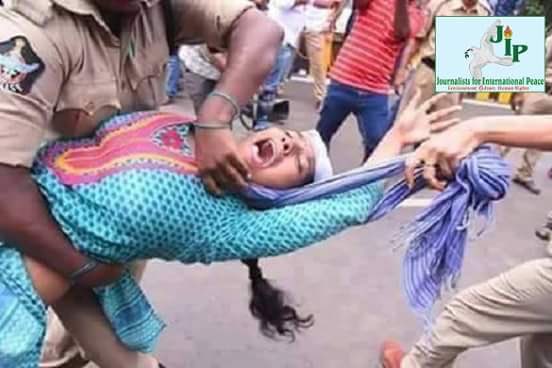
A protestor aims a stone at Indian police in Srinagar: photo by Shuaib Masoodi via The Indian Express, 4 September 2016

Masked protesters in #Kashmir must be shot at. Soldiers and cops have clear responsibilities. #PakistanJihad: image via Tufail Ahmad Verified account @tufailelif, 3 September 2016

War is different this time PM @narendramodi #Kashmir: image via Syedih @SyedIHusain, 3
September 2016

Father kisses his son, before biding him adieu. yet another victim of atrocities in #Kashmir: image via Kashmir Global @kashmirglobal, 4
September 2016

Bidding him adieu. Yet another victim of atrocities in #Kashmir: image via Kashmir Global @kashmirglobal, 4 September 2016

Scenes from the funeral of slain Basit Ahmad Ahanger. Indian occupied Kashmir: image via Javaid Shaikh @javaidShaikh, 4
September 2016

Bidding him adieu. Yet another victim of atrocities in #Kashmir: image via Kashmir Global @kashmirglobal, 4 September 2016

Technically, if there is a paid stone pelter in #Kashmir, this is it: image by Fouad Farooq @fouadfarooq, 3 September 2016

Indian State terrorism in #Kashmir. Cruelty at its peak: image via Ijaz Ul Haq, 1 September 2016

Sometimes there are no words ... #Kashmir: image via Syed Ali Geelani 1 September 2016


Sometimes there are no words ... #Kashmir: image via Syed Ali Geelani 1 September 2016

The consequences of living in a police state. #Kashmir: image via RA @RichAutumn, 31 August 2016
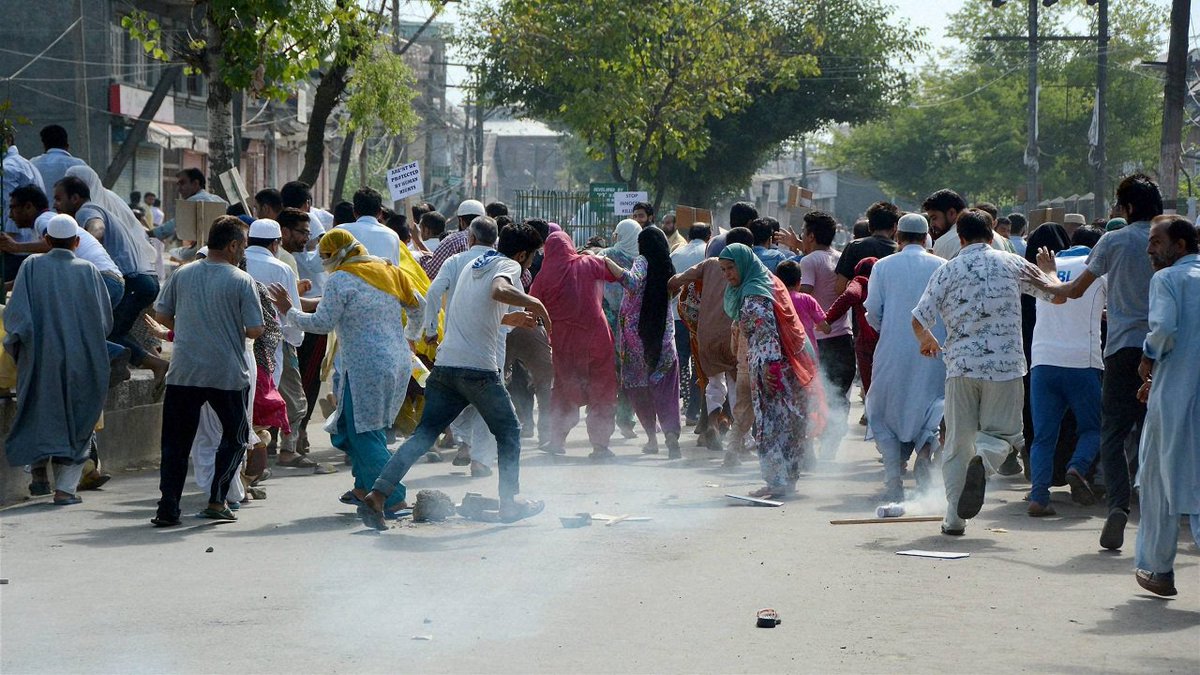
#KashmirUnrest: Protesters in #Shopian set fire to building, curfew in parts of Srinagar: image via Firstpost Verified account @firstpost, 4 September 2016
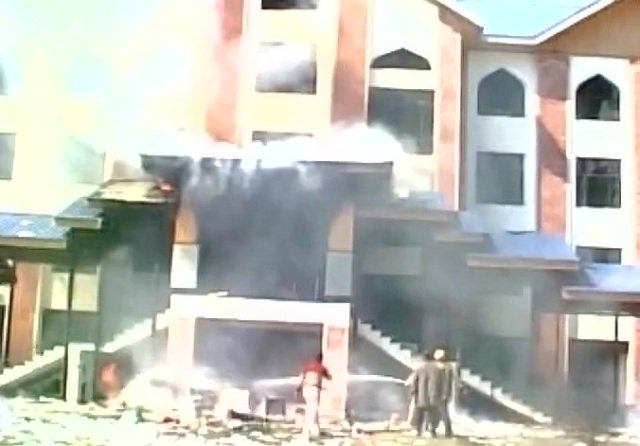
Violence in #Shopian, curfew in parts of #Srinagar: image via ABP News Verified account @abpnewstv, 4 September 2016

hotojournalist Zuhaib Maqbool was hit by pellets while covering a protest in Rainawari Srinagar. @lookaround81: image via Faisal Khan @lookaround81, 4 September 2016

Photojournalist Zuhaib Maqbool was hit by pellets while covering a protest in Rainawari Srinagar. @lookaround81: image via Faisal Khan @lookaround81, 4 September 2016

Photojournalist Zuhaib Maqbool was hit by pellets while covering a protest in Rainawari Srinagar. @lookaround81: image via Faisal Khan @lookaround81, 4 September 2016

Journalists stage protest against the police in Srinagar Kashmir on September 03, 2016. @lookaround81: image via Faisal Khan @lookaround81, 3 September 2016

Record no. of injuries on the day indian HM+30 minstrs visited #Kashmir The humanitarian value system has been hurt: image via Syed Ali Geelani @sageelani, 4 September 2016

Protest against Indian occupation during 58th consecutive day of curfew in Kashmir: photo by Umar Ganie via Rediff News, 4 September 2016

A masked Kashmiri protester throws an Iron grill towards Indian policemen during a protest in Srinagar: photo by AP via the Indian Express, 3 September 2016
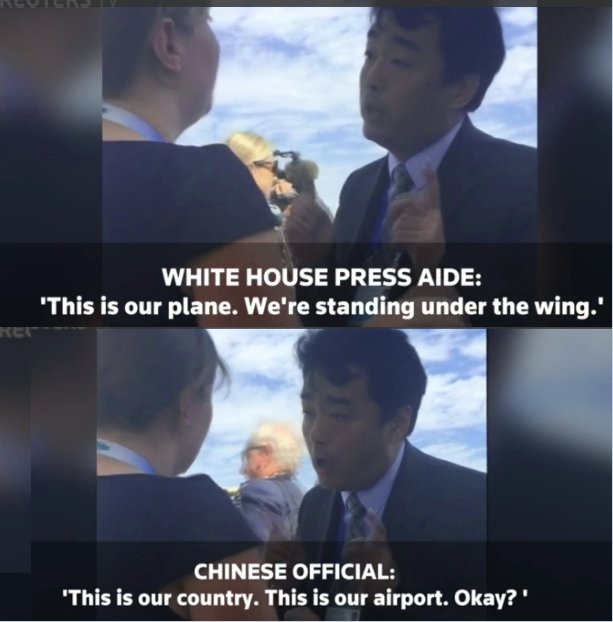
#G20 Yanks off to a good start in Hangzhou. Making like they own the place! #YanksGoHome: image via John Delacour @John Delacour 4 September 2016

GAZA STRIP - A Palestinian waits for travel permits to cross into Egypt through the Rafah border. By @saidkhatib: image via Frédérique Geffard @fgeffardAFP, 4 September 2016
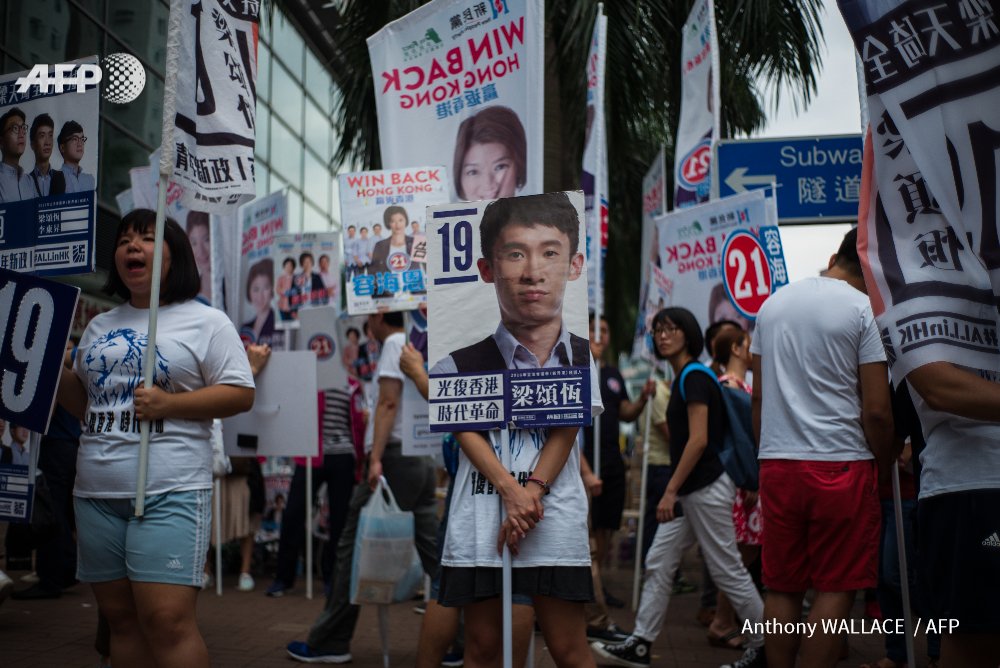
CHINA - A man stands behind a placard of Baggio Leung during Legislative Council election in Hong Kong. By @AntAFP: image via Frédérique Geffard @fgeffardAFP, 4 September 2016
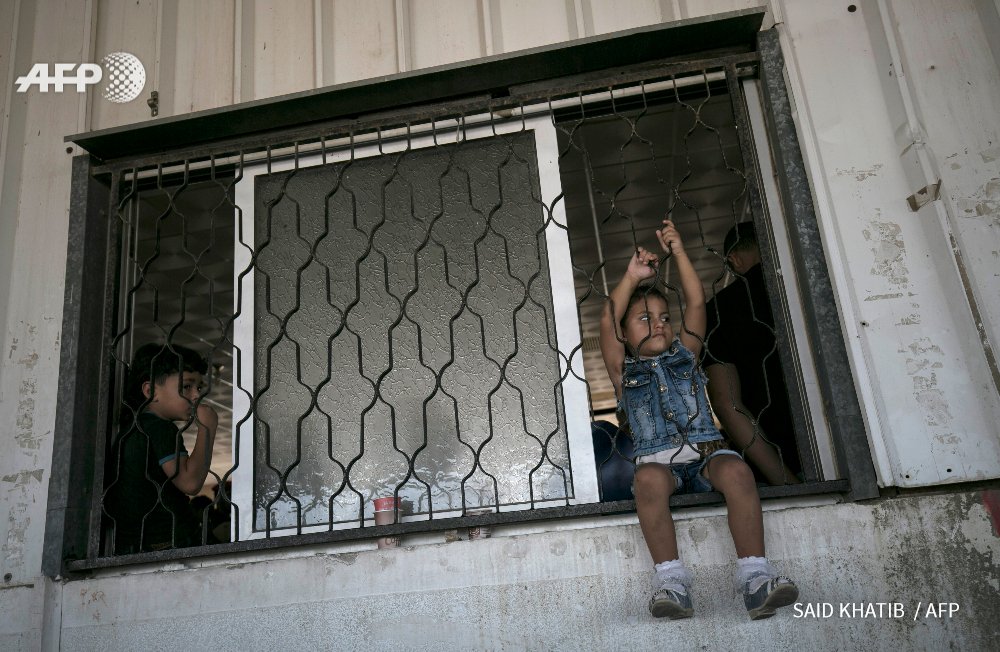
GAZA STRIP - People wait for travel permits to cross into Egypt through Rafah border crossing. By @saidkhatib: image via Frédérique Geffard @fgeffardAFP, 4 September 2016
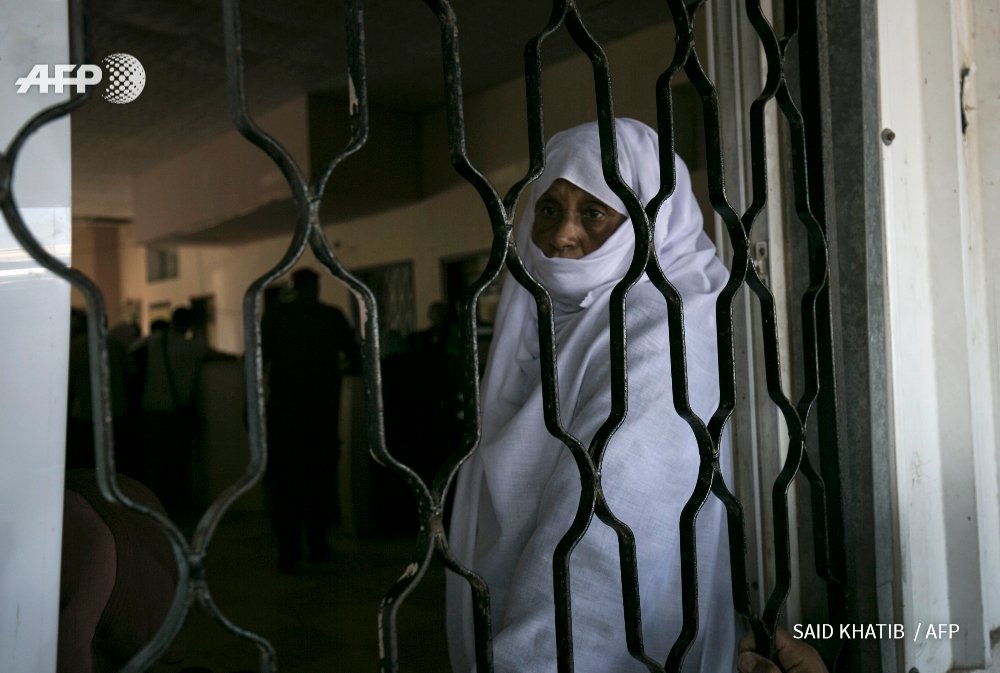
GAZA STRIP - People wait for travel permits to cross into Egypt through Rafah border crossing. By @saidkhatib: image via Frédérique Geffard @fgeffardAFP, 4 September 2016

Chinese honour guards prepare to welcome dignitaries at the Hangzhou Xiaoshan international airport before the G20 Summit in Hangzhou, China: photo by Damir Sagolj / Reuters, 3 September 2016

Willie the Wildcat, the mascot for the Kansas State Wildcats, walks onto the field while his team walks back in to the locker room before their game against the Stanford Cardinal in Palo Alto, California: photo by Ezra Shaw/AFP, 3 September 2016

A Palestinian girl waits to cross into Egypt through the Rafah border crossing after it was opened by Egyptian authorities, in the southern Gaza Strip: photo by Suhaib Salem / Reuters, 3 September 2016

An Indian youth sits on a rickshaw as a motorist drives past idols of the Hindu elephant headed god, Ganesh, draped in polythene on the roadside in Chennai. Hindus across the world are set to celebrate Ganesh Charurthi on September 5: photo by Arun Sankar / AFP, 3 September 2016

Members of the Saudi Arabia delegation arrive at Hangzhou Xiaoshan international airport before the G20 Summit in Hangzhou, Zhejiang province, China: photo by Damir Sagolj/Reuters, 3 September 2016

A picador and his horse fall as a bull charges during the Atlantique corrida in Bayonne: photo by AFP, 4 September 2016

#Syria A damaged street with sandbags used as barriers in #Aleppo's Saif al-Dawla district. By Hosam Katan @Reuters: image via Photojournalism @photojournalink, 3 September 2016

A tale of 2 China's: Glossy surface; Detentions, abductions below @SophieKRW @ChinaFile #G20: image via Human Rights Watch Verified account @hrw, 3 September 2016
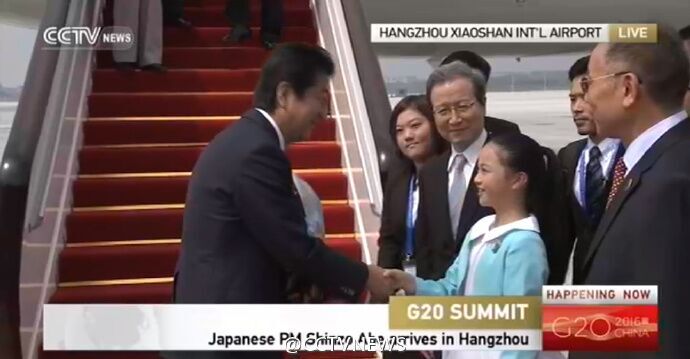
Japanese PM @AbeShinzo arrives in Hangzhou for #G20 Summit: image via People's Daily, China Verified account @PDChina, 3 September 2016

Japanese PM @AbeShinzo arrives in Hangzhou for #G20 Summit: image via People's Daily, China Verified account @PDChina, 3 September 2016
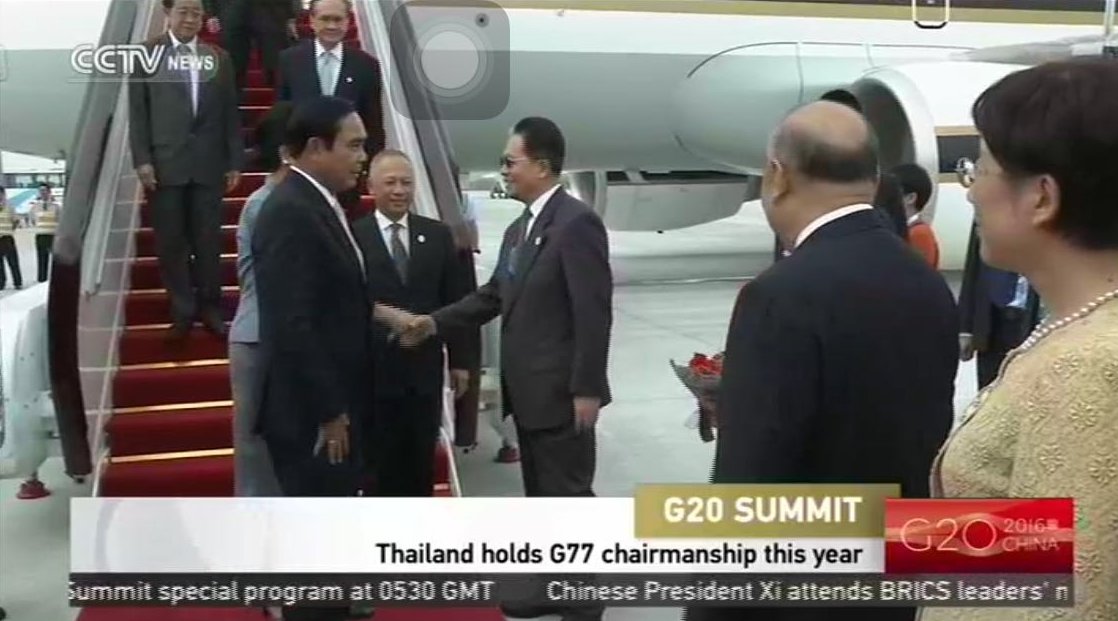
Prime Minister of Thailand Prayut Chan-ocha arrives in Hangzhou for #G20 Summit: image via People's Daily, China Verified account @PDChina, 3 September 2016
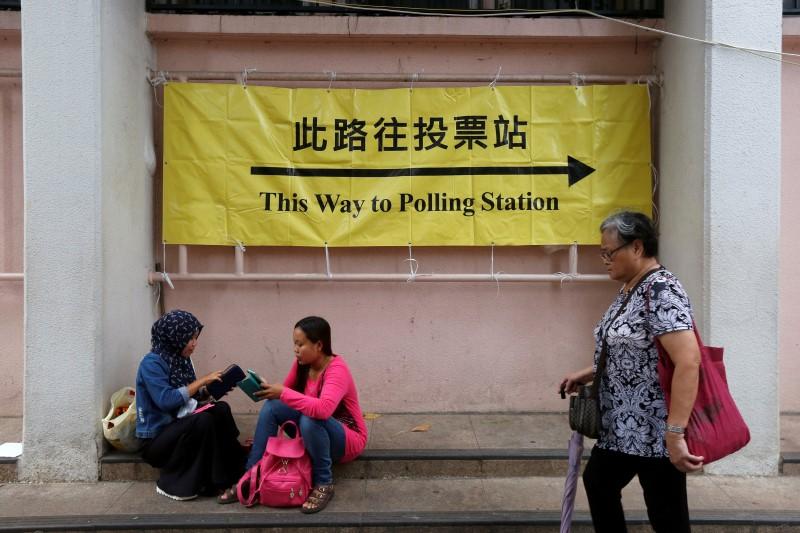
China wary as Hong Kong election exposes underlying strains: image via Reuters Top News @Reuters, 4 September 2016

China's Hangzhou turns ghost town as G20 leaders arrive: image via Reuters Top News @Reuters, 3 September 2016
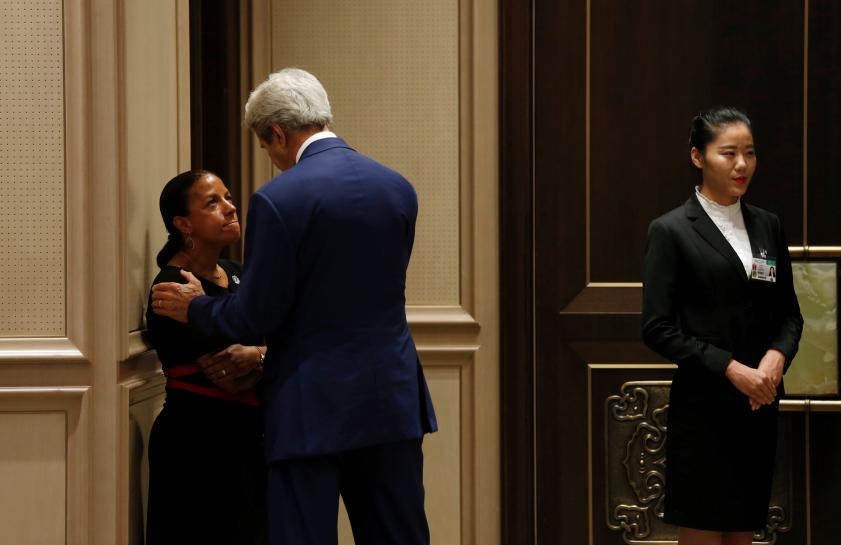
Row on tarmac an awkward G20 start for U.S., China: Reuters, 3 September 2016
The U.S. aide
insisted that the journalists be allowed to stand behind a rope line,
and they were able to record the interaction and Obama's arrival
uninterrupted, typical practice for U.S. press traveling with the
president.
A White House spokesman and China's Foreign Ministry both did not respond immediately to requests for comment.
The altercation occurred out of sight of Obama, who greeted ambassadors and other officials before the presidential motorcade pulled away with Rice.
The incident is an illustration of the image-conscious ruling Communist Party's efforts to control the media as its seeks to orchestrate what it hopes will be a flawless event.
China has taken extensive security measures in preparation for the G20 summit opening on Sunday.
On Saturday, many roads and shops in Hangzhou were deserted and shuttered in the usually bustling city with a population of 9 million.
The Chinese government has broad control over domestic media and prevents many foreign media outlets from publishing in the country, including by blocking their websites.
Obama has raised issues of freedom of the press on previous visits to China, which insists that media must follow the party line and promote "positive propaganda".
Foreign reporters are often physically prevented from covering sensitive stories, but altercations involving foreign government officials are rare.
Rice met Chinese dissidents before her last trip to China in late July, when she held talks with President Xi Jinping and other senior officials.

French business owners and locals blockade the main road into the Port of Calais as they await the arrival of a convoy of trucks protesting against The Jungle migrant camp in Calais, France. Local people and business owners are taking part in the protest, dubbed Operation Escargot, calling for The Jungle camp at the French port to be demolished: photo by Christopher Furlong, 5 September 2016
 .
.
French business owners and locals blockade the main road into the Port of Calais as they await the arrival of a convoy of trucks protesting against The Jungle migrant camp in Calais, France. Local people and business owners are taking part in the protest, dubbed Operation Escargot, calling for The Jungle camp at the French port to be demolished: photo by Christopher Furlong, 5 September 2016
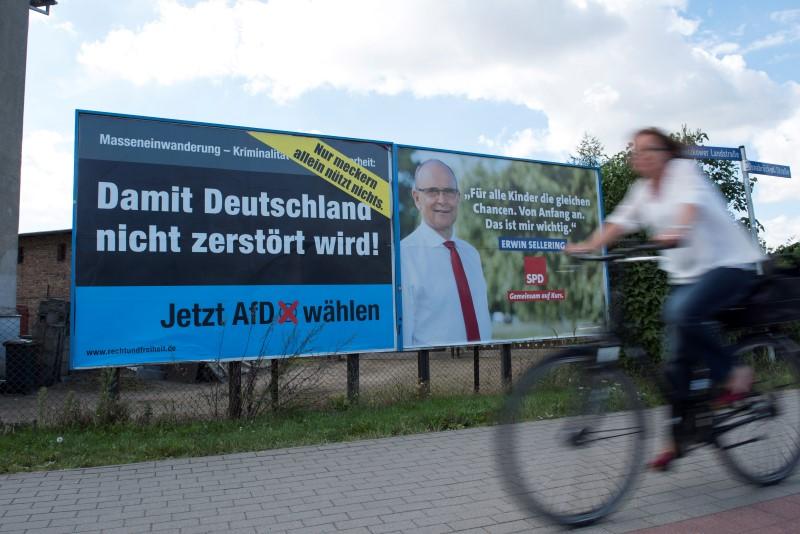
Anti-immigrant party poised for huge win in German state election: image via Reuters Top News @Reuters, 3 September 2016
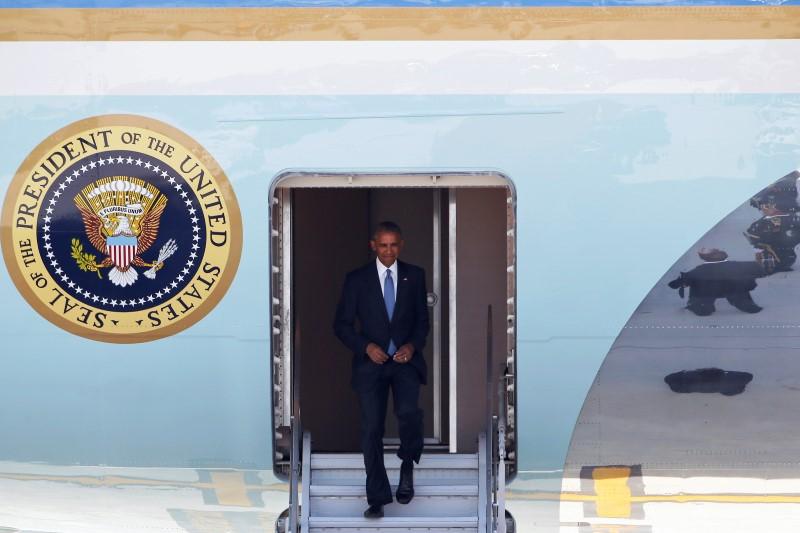
Obama says shouldn't 'overcrank' significance of Hangzhou airport row: image via Reuters Top News @Reuters, 4 September 2016
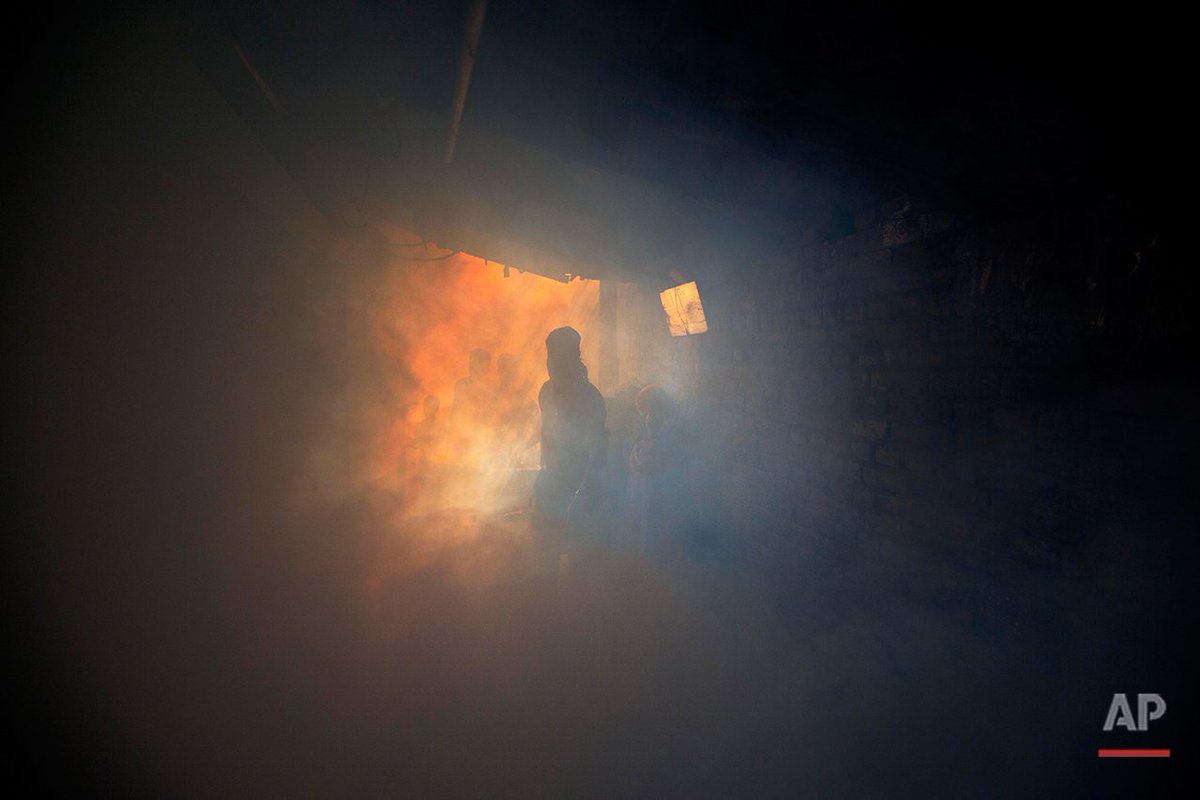
A municipal worker fumigates an alley to prevent the spread of mosquito-borne diseases in New Delhi. @ManishSwarup: image via AP Images @AP_Images, 3 September 2016
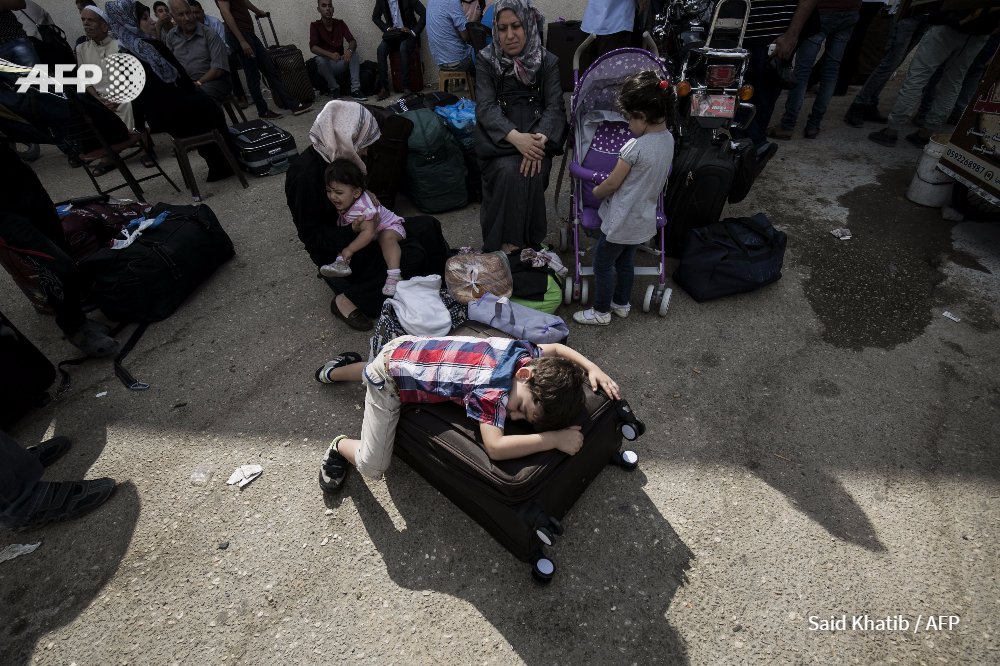
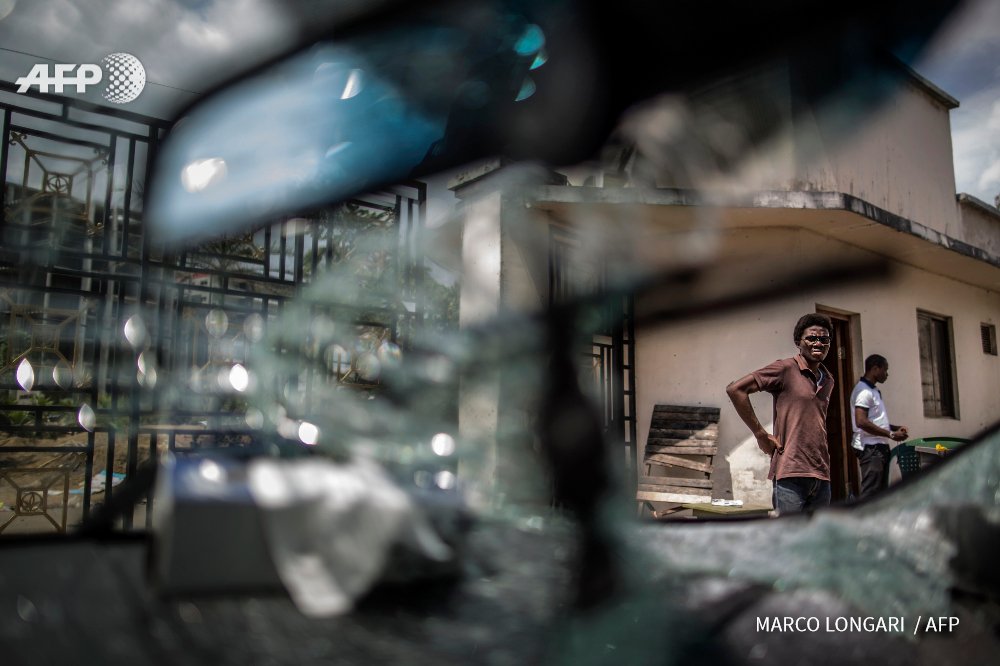
GABON - Post-election violence in Libreville inside the opposition leader Jean Ping's headquarters. By @mlongari: image via Frédérique Geffard @fgeffardAFP, 3 September 2016

The windscreen of a car inside of Gabon’s opposition leader Jean Ping’s headquarters in Libreville is shattered. Post-election violence in Gabon has claimed two more lives, sources said September 2, after President Ali Bongo was proclaimed winner of last week’s vote while main challenger Jean Ping claimed victory for himself. One of the two new victims was a policeman, the first member of the Gabonese security forces listed as killed in the violence sparked by the announcement on August 31 of Bongo’s victory in last weekend’s election.: photo by Marco Longari / AFP, 4 September 2016

Riot police clash with supporters of Brazil’s sacked ex-president Dilma Rousseff who demonstrate four days after she was impeached by the Senate, along Paulista Avenue in Sao Paulo, Brazil. The 68-year-old leftist leader must leave the Alvorada official residence in Brasilia within a month after senators voted on August 31 to fire her over charges she illegally manipulated the national budget. Rousseff said she will continue the fight against her successor Michel Temer from her adopted hometown, Porto Alegre.: photo by AFP, 5 September 2016

Followers of dismissed Brazilian president Dilma Rousseff demonstrate in Sao Paulo: photo by EPA, 5 September 2016
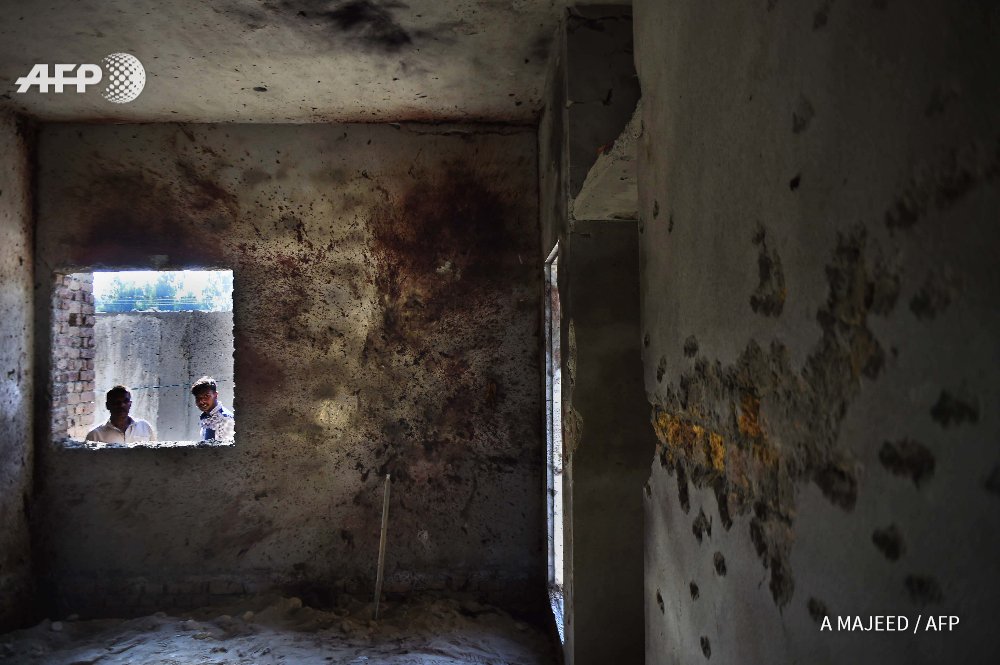
PAKISTAN - Christians look at a damaged house in a Christian Colony on the outskirts of Peshawar. By A Majeed: image via Frédérique Geffard @fgeffardAFP, 4 September 2016
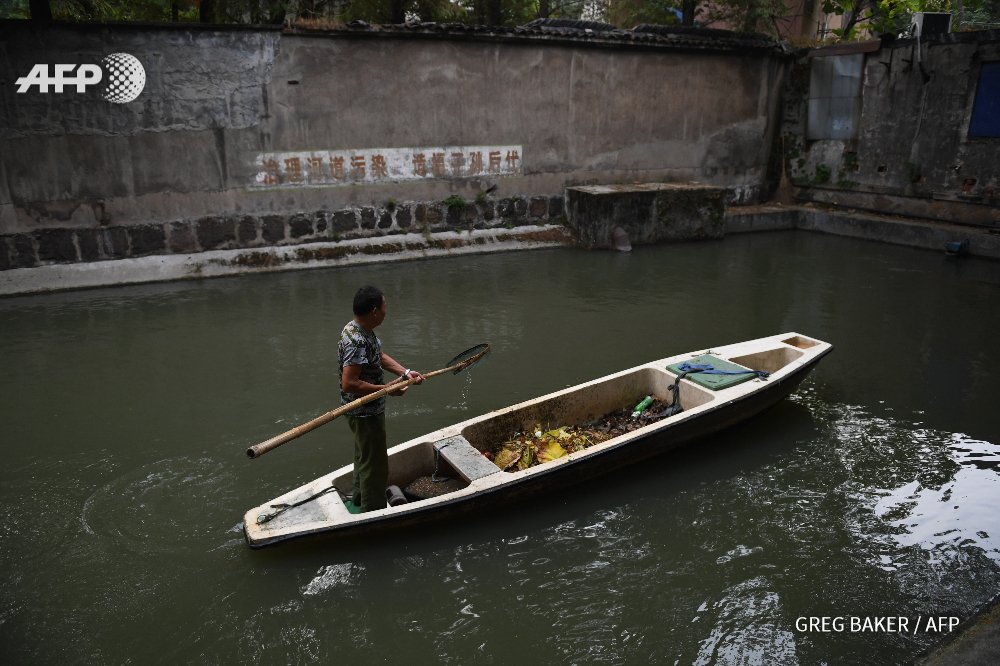
CHINA - A man clears trash from a canal in Hangzhou ahead the G20 Leaders Summit. By Greg Baker #AFP: image via Frédérique Geffard @fgeffardAFP, 4 September 2016
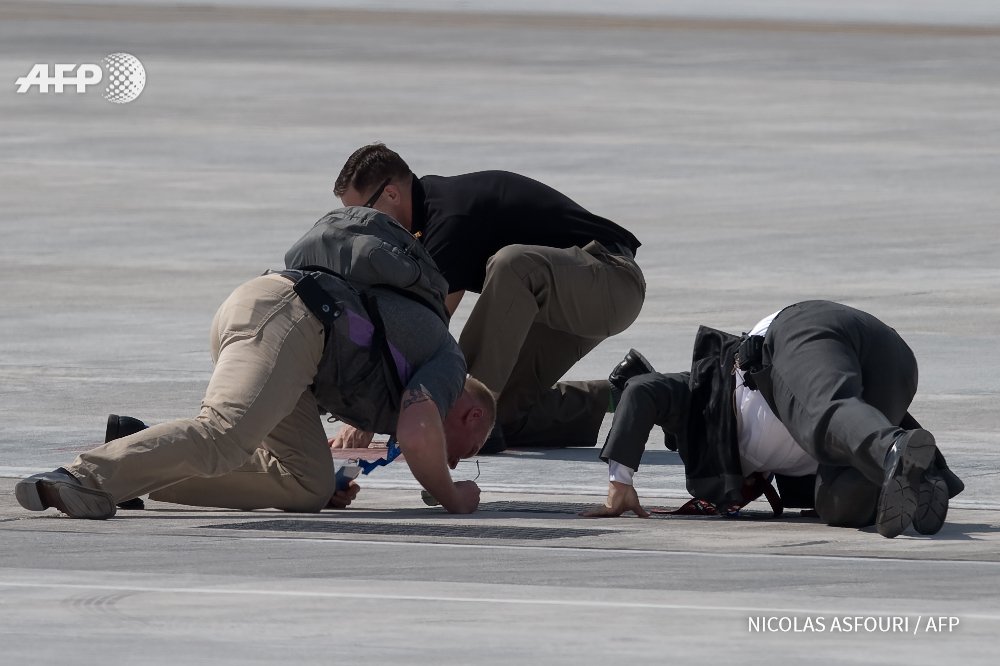
CHINA - US security personnel inspect parts of airport before arrival of US President Obama in Hangzhou. By @NAsfouri: image via Frédérique Geffard @fgeffardAFP, 4 September 2016
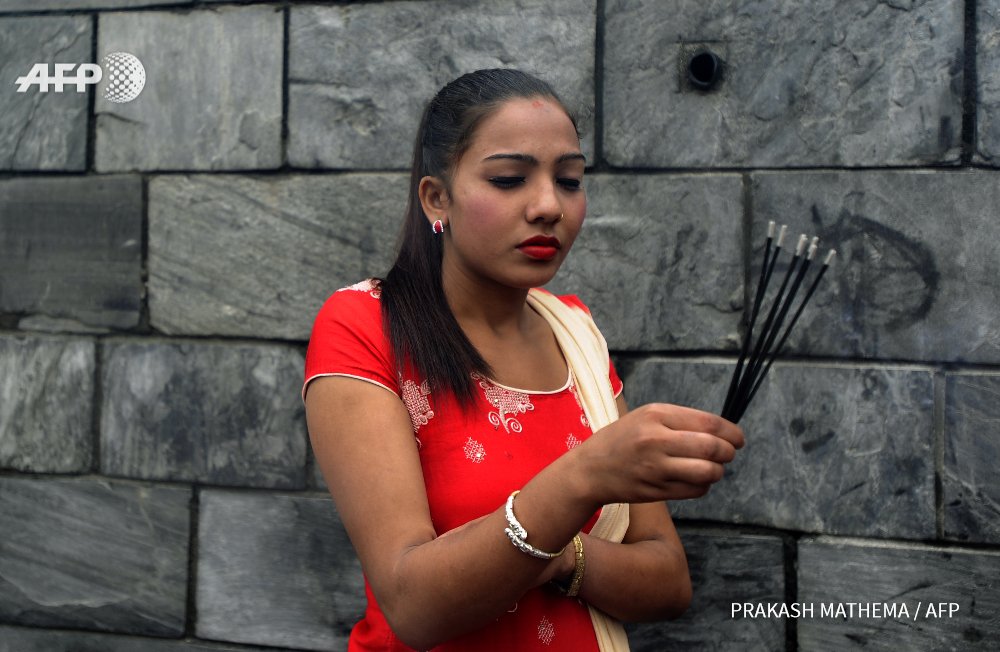
NEPAL - A Hindu woman celebrates the Teej festival at the Pashupatinath temple in Kathmandu. By @PrakashMathema #AFP: image via Frédérique Geffard @fgeffardAFP, 4 September 2016


#KashmirUnrest: Protesters in #Shopian set fire to building, curfew in parts of Srinagar: image via Firstpost Verified account @firstpost, 4 September 2016

Violence in #Shopian, curfew in parts of #Srinagar: image via ABP News Verified account @abpnewstv, 4 September 2016

hotojournalist Zuhaib Maqbool was hit by pellets while covering a protest in Rainawari Srinagar. @lookaround81: image via Faisal Khan @lookaround81, 4 September 2016

Photojournalist Zuhaib Maqbool was hit by pellets while covering a protest in Rainawari Srinagar. @lookaround81: image via Faisal Khan @lookaround81, 4 September 2016

Photojournalist Zuhaib Maqbool was hit by pellets while covering a protest in Rainawari Srinagar. @lookaround81: image via Faisal Khan @lookaround81, 4 September 2016

Journalists stage protest against the police in Srinagar Kashmir on September 03, 2016. @lookaround81: image via Faisal Khan @lookaround81, 3 September 2016

Record no. of injuries on the day indian HM+30 minstrs visited #Kashmir The humanitarian value system has been hurt: image via Syed Ali Geelani @sageelani, 4 September 2016
Protest against Indian occupation during 58th consecutive day of curfew in Kashmir: photo by Umar Ganie via Rediff News, 4 September 2016
More than 200 people were injured in clashes between stone pelters
and security forces in Kashmir on Sunday, on a day an all-party
parliamentary delegation was in Srinagar to assess the ground situation
in the valley where normal life remained paralysed for 58th consecutive
day.
There was no curfew in the valley except some areas of Srinagar
falling under the Police Stations of Khanyar, Safakadal, Nowhatta,
Rainawari and M R Gunj, a police spokesman said.
Ten incidents of stone pelting were reported from Srinagar, Anantnag, Pulwama, Kulgam, Shopian, Awantipora and Sopore, he said.
In Shopian district of south Kashmir, clashes broke out in the
morning and continued for most part of the day with protesters setting
ablaze the mini-secretariat building which houses the deputy
commissioner’s office, a police official said.
“In Shopian, a mob attacked and set ablaze mini secretariat Shopian.
The fire was brought under control. However, the structure suffered
partial damage,” he said.
The clashes erupted after police stopped people in Penjoora village
of the district from taking out a rally, the official said, adding over
100 people were injured.
He said the security forces used baton charge and tear-gas shelling to disperse the protesters.
Clashes were also reported from Tral area of Pulwama district where
more than 60 people were hurt in action by security forces against the
stone pelters.
“In Tral, a huge mob pelted stones on the police and security forces. Some of the miscreants, when chased, entered a ziyarat (shrine) and again started pelting stones from the compound of the ziyarat,” the spokesman said, adding police “cautiously” handled the situation.
Protesters also attacked the house of ruling Peoples Democratic Party
MLA from Tral constituency Mushtaq Ahmad Shah, breaking the window
panes of the building.
“There were clashes between protesters and security forces in Tral
and amidst those clashes, some miscreants attacked the house of Tral
legislator Mushtaq Ahmad Shah with stones,” a police official said.
He said the protesters broke the window panes of the house, but no
one was injured. The forces deployed in the area fired several tear-gas
canisters and managed to disperse the protesters from the spot, the
official said.
In Sopore town of north Kashmir’s Baramulla district, at least 25
people were hurt in the clashes during the day, the official said.
Condition of three of the injured persons is stated to be critical.
Giving details of the violence, the police spokesman said “mobs
assembled on the roads and attempted to disturb the normal traffic and
movement of people by pelting stones on vehicles and later on at police
and security force deployments”.
On Saturday, protesters in the neighbouring Kulgam district burnt a
house of the ruling Peoples Democratic Party block president Gulzar
Ahmad who had facilitated a meeting of Chief Minister Mehbooba Mufti
with the family of a victim of security forces firing in the district.
Mehbooba visited the family of Late Mashooq Ahmed, firing victim of
Kund, Kulgam and offered heartfelt condolences to the bereaved family on
Saturday.
Normal life in the Valley remained paralysed for the 58th day as
restrictions continued in the rest of the Valley which has been hit by
violence triggered by the killing of Hizbul Mujahideen militant Burhan
Wani on July 8.
“Curfew remains in force in five police station areas of downtown Srinagar,” a police spokesman said.
He said curfew in these areas of the summer capital continued as a
precautionary measure in view of the call given by separatists asking
people to occupy Airport road, city centre Lal Chowk and district
headquarters against the all-party delegation’s visit.
Due to the restrictions and separatist-sponsored shutdown, shops,
business establishments and petrol pumps continued to remain shut during
the day. They are opened only in the evening. Public transport
continued to be off the roads.
As many as 71 persons, including two police personnel, have been
killed and several thousand others injured in the clashes between
protesters and security forces in the Valley since Wani was killed in an
encounter in south Kashmir on July 8.
A masked Kashmiri protester throws an Iron grill towards Indian policemen during a protest in Srinagar: photo by AP via the Indian Express, 3 September 2016

#G20 Yanks off to a good start in Hangzhou. Making like they own the place! #YanksGoHome: image via John Delacour @John Delacour 4 September 2016
‘This is our country’
A fiery sky over St Mary’s Lighthouse near Whitley Bay, Tyne and Wear, as warm weather is forecast for the week in England: photo by Owen Humphreys/PA, 5 September 2016
Florence Margaret "Stevie" Smith (1902-1971): The Sea-widow, from Scorpion and Other Poems, 1972
An Iraqi soldier stands next to a wall with a red cross above a slogan of the Islamic State in the city of Fallujah: photo by Ahmad Al-Rubaye/AFP, 5 September 2016
An Iraqi soldier stands next to a wall with a red cross above a slogan of the Islamic State in the city of Fallujah: photo by Ahmad Al-Rubaye/AFP, 5 September 2016
A man fills barrels with rubble to make a barricade to protect shops in the rebel held Douma neighbourhood of Damascus, Syria: photo by Bassam Khabieh/Reuters, 2 September 2016
A young boy pushes a wheelbarrow with wood next to a young girl on the Turkish-Syrian border town of Karkamis, in the southern region of Gaziantep, near Syrian-Turkish border town of Jarabulus: photo by Bulent Kilic/AFP, 2 September 2016

A young boy pushes a wheelbarrow with wood next to a young girl on the Turkish-Syrian border town of Karkamis, in the southern region of Gaziantep, near Syrian-Turkish border town of Jarabulus: photo by Bulent Kilic/AFP, 2 September 2016
A fiery sky over St Mary’s Lighthouse near Whitley Bay, Tyne and Wear, as warm weather is forecast for the week in England: photo by Owen Humphreys/PA, 5 September 2016
A fiery sky over St Mary’s Lighthouse near Whitley Bay, Tyne and Wear, as warm weather is forecast for the week in England: photo by Owen Humphreys/PA, 5 September 2016
Stevie Smith: The Sea-widow
How fares it with you, Mrs Cooper my bride?
Long are the years since you lay by my side.
Do you wish I was back? Do you speak of me dearest?
I wish you were back for me to hold nearest.
Who then lies nearer, Mrs Cooper my bride?
A black man comes in with the evening tide.
What is his name? Tell me! How does he dare?
He comes uninvited. His name is Despair.
Florence Margaret "Stevie" Smith (1902-1971): The Sea-widow, from Scorpion and Other Poems, 1972
An Iraqi soldier stands next to a wall with a red cross above a slogan of the Islamic State in the city of Fallujah: photo by Ahmad Al-Rubaye/AFP, 5 September 2016
An Iraqi soldier stands next to a wall with a red cross above a slogan of the Islamic State in the city of Fallujah: photo by Ahmad Al-Rubaye/AFP, 5 September 2016
A man fills barrels with rubble to make a barricade to protect shops in the rebel held Douma neighbourhood of Damascus, Syria: photo by Bassam Khabieh/Reuters, 2 September 2016
A man fills barrels with rubble to make a barricade to protect shops in the rebel held Douma neighbourhood of Damascus, Syria: photo by Bassam Khabieh/Reuters, 2 September 2016
A young boy pushes a wheelbarrow with wood next to a young girl on the Turkish-Syrian border town of Karkamis, in the southern region of Gaziantep, near Syrian-Turkish border town of Jarabulus: photo by Bulent Kilic/AFP, 2 September 2016
A young boy pushes a wheelbarrow with wood next to a young girl on the Turkish-Syrian border town of Karkamis, in the southern region of Gaziantep, near Syrian-Turkish border town of Jarabulus: photo by Bulent Kilic/AFP, 2 September 2016

GAZA STRIP - A Palestinian waits for travel permits to cross into Egypt through the Rafah border. By @saidkhatib: image via Frédérique Geffard @fgeffardAFP, 4 September 2016

CHINA - A man stands behind a placard of Baggio Leung during Legislative Council election in Hong Kong. By @AntAFP: image via Frédérique Geffard @fgeffardAFP, 4 September 2016

GAZA STRIP - People wait for travel permits to cross into Egypt through Rafah border crossing. By @saidkhatib: image via Frédérique Geffard @fgeffardAFP, 4 September 2016

GAZA STRIP - People wait for travel permits to cross into Egypt through Rafah border crossing. By @saidkhatib: image via Frédérique Geffard @fgeffardAFP, 4 September 2016
Chinese honour guards prepare to welcome dignitaries at the Hangzhou Xiaoshan international airport before the G20 Summit in Hangzhou, China: photo by Damir Sagolj / Reuters, 3 September 2016
Willie the Wildcat, the mascot for the Kansas State Wildcats, walks onto the field while his team walks back in to the locker room before their game against the Stanford Cardinal in Palo Alto, California: photo by Ezra Shaw/AFP, 3 September 2016
A Palestinian girl waits to cross into Egypt through the Rafah border crossing after it was opened by Egyptian authorities, in the southern Gaza Strip: photo by Suhaib Salem / Reuters, 3 September 2016
An Indian Hindu devotee transports an idol of the elephant-headed
Hindu god, Lord Ganesha in his car, for Ganesh Chaturthi in Mumbai. The
Ganesh Chaturthi festival, a popular 11-day religious festival which is
annually celebrated across India.: photo by Punit Paranj/AFP, 5 September 2016

An Indian Hindu devotee transports an idol of the elephant-headed Hindu god, Lord Ganesha in his car, for Ganesh Chaturthi in Mumbai. The Ganesh Chaturthi festival, a popular 11-day religious festival which is annually celebrated across India.: photo by Punit Paranj/AFP, 5 September 2016
An Indian Hindu devotee transports an idol of the elephant-headed Hindu god, Lord Ganesha in his car, for Ganesh Chaturthi in Mumbai. The Ganesh Chaturthi festival, a popular 11-day religious festival which is annually celebrated across India.: photo by Punit Paranj/AFP, 5 September 2016
An Indian youth sits on a rickshaw as a motorist drives past idols of the Hindu elephant headed god, Ganesh, draped in polythene on the roadside in Chennai. Hindus across the world are set to celebrate Ganesh Charurthi on September 5: photo by Arun Sankar / AFP, 3 September 2016
Members of the Saudi Arabia delegation arrive at Hangzhou Xiaoshan international airport before the G20 Summit in Hangzhou, Zhejiang province, China: photo by Damir Sagolj/Reuters, 3 September 2016
A picador and his horse fall as a bull charges during the Atlantique corrida in Bayonne: photo by AFP, 4 September 2016

#Syria A damaged street with sandbags used as barriers in #Aleppo's Saif al-Dawla district. By Hosam Katan @Reuters: image via Photojournalism @photojournalink, 3 September 2016

A tale of 2 China's: Glossy surface; Detentions, abductions below @SophieKRW @ChinaFile #G20: image via Human Rights Watch Verified account @hrw, 3 September 2016

Japanese PM @AbeShinzo arrives in Hangzhou for #G20 Summit: image via People's Daily, China Verified account @PDChina, 3 September 2016

Japanese PM @AbeShinzo arrives in Hangzhou for #G20 Summit: image via People's Daily, China Verified account @PDChina, 3 September 2016

Prime Minister of Thailand Prayut Chan-ocha arrives in Hangzhou for #G20 Summit: image via People's Daily, China Verified account @PDChina, 3 September 2016


China's Hangzhou turns ghost town as G20 leaders arrive: image via Reuters Top News @Reuters, 3 September 2016

Row on tarmac an awkward G20 start for U.S., China [U.S. National Security Advisor Susan
Rice (L) and Secretary of State John Kerry talk at a Paris agreement
climate change event ahead of the G20 Summit, at West Lake Statehouse in
Hangzhou, China, September 3, 2016.
REUTERS/Jonathan Ernst]: image via Reuters Top News @Reuters, 3 September 2016
A Chinese official confronted U.S.
President Barack Obama's national security adviser on the tarmac on
Saturday prompting the Secret Service to intervene, an unusual
altercation as China implements strict controls ahead of a big summit.
The stakes are high for China to pull off a trouble-free G20 summit of the world's top economies, its highest profile event of the year, as it looks to cement its global standing and avoid acrimony over a long list of tensions with Washington.
Shortly after Obama's plane landed in the eastern city of Hangzhou, a Chinese official attempted to prevent his national security adviser Susan Rice from walking to the motorcade as she crossed a media rope line, speaking angrily to her before a Secret Service agent stepped between the two.
Rice responded but her comments were inaudible to reporters standing underneath the wing of Air Force One. It was unclear if the official, whose name was not immediately clear, knew that Rice was a senior official and not a reporter.
The same official shouted at a White House press aide who was instructing foreign reporters on where to stand as they recorded Obama disembarking from the plane.
"This is our country. This is our airport," the official said in English, pointing and speaking angrily with the aide.
The stakes are high for China to pull off a trouble-free G20 summit of the world's top economies, its highest profile event of the year, as it looks to cement its global standing and avoid acrimony over a long list of tensions with Washington.
Shortly after Obama's plane landed in the eastern city of Hangzhou, a Chinese official attempted to prevent his national security adviser Susan Rice from walking to the motorcade as she crossed a media rope line, speaking angrily to her before a Secret Service agent stepped between the two.
Rice responded but her comments were inaudible to reporters standing underneath the wing of Air Force One. It was unclear if the official, whose name was not immediately clear, knew that Rice was a senior official and not a reporter.
The same official shouted at a White House press aide who was instructing foreign reporters on where to stand as they recorded Obama disembarking from the plane.
"This is our country. This is our airport," the official said in English, pointing and speaking angrily with the aide.
A White House spokesman and China's Foreign Ministry both did not respond immediately to requests for comment.
The altercation occurred out of sight of Obama, who greeted ambassadors and other officials before the presidential motorcade pulled away with Rice.
The incident is an illustration of the image-conscious ruling Communist Party's efforts to control the media as its seeks to orchestrate what it hopes will be a flawless event.
China has taken extensive security measures in preparation for the G20 summit opening on Sunday.
On Saturday, many roads and shops in Hangzhou were deserted and shuttered in the usually bustling city with a population of 9 million.
The Chinese government has broad control over domestic media and prevents many foreign media outlets from publishing in the country, including by blocking their websites.
Obama has raised issues of freedom of the press on previous visits to China, which insists that media must follow the party line and promote "positive propaganda".
Foreign reporters are often physically prevented from covering sensitive stories, but altercations involving foreign government officials are rare.
Rice met Chinese dissidents before her last trip to China in late July, when she held talks with President Xi Jinping and other senior officials.
French business owners and locals blockade the main road into the Port of Calais as they await the arrival of a convoy of trucks protesting against The Jungle migrant camp in Calais, France. Local people and business owners are taking part in the protest, dubbed Operation Escargot, calling for The Jungle camp at the French port to be demolished: photo by Christopher Furlong, 5 September 2016
French business owners and locals blockade the main road into the Port of Calais as they await the arrival of a convoy of trucks protesting against The Jungle migrant camp in Calais, France. Local people and business owners are taking part in the protest, dubbed Operation Escargot, calling for The Jungle camp at the French port to be demolished: photo by Christopher Furlong, 5 September 2016

Anti-immigrant party poised for huge win in German state election: image via Reuters Top News @Reuters, 3 September 2016

Obama says shouldn't 'overcrank' significance of Hangzhou airport row: image via Reuters Top News @Reuters, 4 September 2016

A municipal worker fumigates an alley to prevent the spread of mosquito-borne diseases in New Delhi. @ManishSwarup: image via AP Images @AP_Images, 3 September 2016

#Palestinians wait for travel permits to cross into
Egypt through the Rafah border #Gaza #AFP Photo by @saidkhatib: image
via Aurelia BAILLY @AureliaBAILLY, 3 September 2016

GABON - Post-election violence in Libreville inside the opposition leader Jean Ping's headquarters. By @mlongari: image via Frédérique Geffard @fgeffardAFP, 3 September 2016
The windscreen of a car inside of Gabon’s opposition leader Jean Ping’s headquarters in Libreville is shattered. Post-election violence in Gabon has claimed two more lives, sources said September 2, after President Ali Bongo was proclaimed winner of last week’s vote while main challenger Jean Ping claimed victory for himself. One of the two new victims was a policeman, the first member of the Gabonese security forces listed as killed in the violence sparked by the announcement on August 31 of Bongo’s victory in last weekend’s election.: photo by Marco Longari / AFP, 4 September 2016
Riot police clash with supporters of Brazil’s sacked ex-president Dilma Rousseff who demonstrate four days after she was impeached by the Senate, along Paulista Avenue in Sao Paulo, Brazil. The 68-year-old leftist leader must leave the Alvorada official residence in Brasilia within a month after senators voted on August 31 to fire her over charges she illegally manipulated the national budget. Rousseff said she will continue the fight against her successor Michel Temer from her adopted hometown, Porto Alegre.: photo by AFP, 5 September 2016
Followers of dismissed Brazilian president Dilma Rousseff demonstrate in Sao Paulo: photo by EPA, 5 September 2016

PAKISTAN - Christians look at a damaged house in a Christian Colony on the outskirts of Peshawar. By A Majeed: image via Frédérique Geffard @fgeffardAFP, 4 September 2016

CHINA - A man clears trash from a canal in Hangzhou ahead the G20 Leaders Summit. By Greg Baker #AFP: image via Frédérique Geffard @fgeffardAFP, 4 September 2016

CHINA - US security personnel inspect parts of airport before arrival of US President Obama in Hangzhou. By @NAsfouri: image via Frédérique Geffard @fgeffardAFP, 4 September 2016

NEPAL - A Hindu woman celebrates the Teej festival at the Pashupatinath temple in Kathmandu. By @PrakashMathema #AFP: image via Frédérique Geffard @fgeffardAFP, 4 September 2016

Happy #shoutoutsunday! Today we're featuring the
beautiful work of photographer @finbarroreilly who recently
return… [Dakar Fashion Week in Senegal]: image via Everyday Africa
@Everyday Africa,12 June 2016

An Afghan youth gestures as the sun sets on the outskirts of Herat: photo by Aref Karimi / AFP, 3 September 2016
An Afghan youth gestures as the sun sets on the outskirts of Herat: photo by Aref Karimi / AFP, 3 September 2016



3 comments:
Stevie Smith reads The Sea-widow
beautiful poem !
Sandra, lovely to hear you like Stevie Smith.
I do too!
Family Photo / Stevie Smith: I Remember
Post a Comment